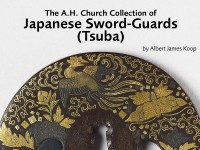The A. H. Church Collection of Japanese Sword-Guards (Tsuba)
An unpublished catalogue of the A. H. Church collection of Japanese sword-guards (tsuba) by Albert James Koop.

Publications online: 1264 objects
Tsuba with symbols of poem-writing at the Tanabata Festival
-
Literature notes
Rounded oblong; the front represents an ink-stone (suzuri) with its shallow depression within the unevenly wide border; across this is modelled a large leaf of kaji (paper-mulberry) with nunome-gilt stem and venation; on the border are a few clouds engraved and a constellation (two groups of three disks joined by lines) in gilding.
On the back, within a raised border of irregular inner profile, are modelled a writing-brush (hairs in silver and shakudō) and a worn stick of ink (enriched with silver and gold), inscribed with its brand Taikwa...[Japanese text].
The whole design is symbolic of poem-writing at the Tanabata festival and it is the Weaver (Tanabata) constellation that is represented on the border of the ink-stone. -
Details
- Associated place
- Date
- 18th century (1701 - 1800)
- Artist/maker
-
Umetada School (active 16th century - 19th century) (armourer)
- Material and technique
- obverse and reverse: iron; tang-hole plugged with soft metal, probably copper obverse: with engraved decoration, gilding, and gilt nunome-zōgan decoration reverse: with silver, shakudō, and gold
- Dimensions
- 7.7 x 7 x 0.5 cm (height x width x depth)
- Material index
-
processed material › metal › iron,processed material › metal › gold,processed material › metal › alloy › copper alloy › shakudō,
- Technique index
-
covered › metallized › gilded,
- Object type index
-
arms/armour › koshirae › kodogu › tsuba
- No. of items
- 1
- Credit line
- Bequeathed by Sir Arthur H. Church, 1915.
- Accession no.
- EAX.10207
-
Further reading
Koop, Albert James, The A. H. Church Collection of Japanese Sword-Guards (Tsuba), 3 vols (Oxford, Ashmolean Museum, 1929), no. 207
Glossary (3)
nunome-zōgan, shakudō, tsuba
-
nunome-zōgan
Decorative application of metal sheeting (generally of gold or silver) where the iron ground is first cross-hatched and the metal burnished on.
-
shakudō
alloy of copper and gold, patinated to a dark blue-black colour
-
tsuba
Japanese sword guard.
Location
-
- currently in research collection
Objects are sometimes moved to a different location. Our object location data is usually updated on a monthly basis. Contact the Jameel Study Centre if you are planning to visit the museum to see a particular object on display, or would like to arrange an appointment to see an object in our reserve collections.
Publications online
-

The A. H. Church Collection of Japanese Sword-Guards (Tsuba)
Rounded oblong; the front represents an ink-stone (suzuri) with its shallow depression within the unevenly wide border; across this is modelled a large leaf of kaji (paper-mulberry) with nunome-gilt stem and venation; on the border are a few clouds engraved and a constellation (two groups of three disks joined by lines) in gilding.
On the back, within a raised border of irregular inner profile, are modelled a writing-brush (hairs in silver and shakudō) and a worn stick of ink (enriched with silver and gold), inscribed with its brand Taikwa...[Japanese text].
The whole design is symbolic of poem-writing at the Tanabata festival and it is the Weaver (Tanabata) constellation that is represented on the border of the ink-stone.
Notice
Object information may not accurately reflect the actual contents of the original publication, since our online objects contain current information held in our collections database. Click on 'buy this publication' to purchase printed versions of our online publications, where available, or contact the Jameel Study Centre to arrange access to books on our collections that are now out of print.
© 2013 University of Oxford - Ashmolean Museum

